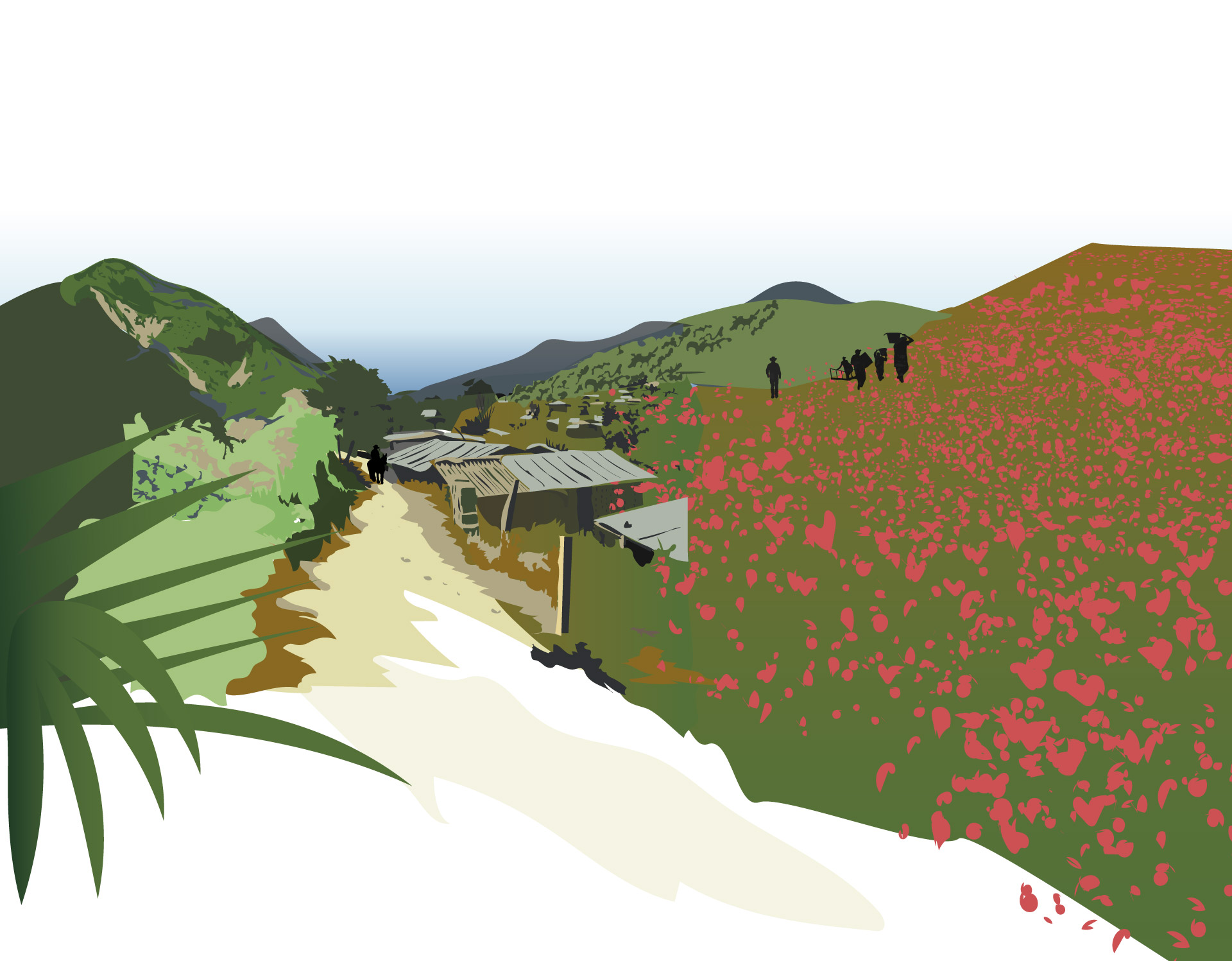This is the 1st Chapter of our Opium Project.
Introduction
Mexico is one of the main producers of illegal poppies in the world. 1This commonly accepted statement, which serves as a justification for eradication campaigns, clashes with the scarcity of studies that seek to understand what this crop represents in the national and local agricultural panorama.
Through data analysis, this text proposes to explore precisely where opium poppy grows in Mexico and what are other types of legal crops that grow next to poppy fields. The hypothesis that guided these questions is that, although poppy fields share certain topographic and climatic characteristics among them, they are also distinguished by a great diversity of agricultural production scenarios that draw an unequal panorama of dependence on their cultivation.
Our research strategy started from the analysis of two data sets. On the one hand, the statistics of agricultural production systematized by the Agri-food and Fisheries Information Service (SIAP, by its Spanish acronym)2 from 2003 to 2019 and, on the other, the figures registered by the Ministry of National Defense (SEDENA, by its Spanish acronym) on the eradication of crops declared illicit. that we request for the period from 2000 to 2020, both disaggregated at the municipal level. 3
In Mexico there is no systematic record of poppy cultivation that allows monitoring its evolution over time, distribution in the territory and basic characteristics of production (sown areas, prices, yields, among others).
It should be clarified, however, that the decision to approach poppy production through data on its destruction responded to two limits that quantitative research currently faces when it tries to study economies declared as illegal.
Firstly, in Mexico there is no systematic record of poppy cultivation that allows monitoring its evolution over time, distribution in the territory and basic characteristics of production (sown areas, prices, yields, among others). Information that SIAP does collect, for example, for legal crops. On the other hand, although the national regulatory framework indicates that the Attorney General’s Office is the institution responsible for authorizing the eradication of crops declared illegal in the country and for checking the information contained in all the records of destruction,4 it does not provide information disaggregated at the local level, only data aggregated by state.5

In this context, given that our objective is to identify the poppy growing areas in the country and study aspects of agricultural production in each one of them, we are forced to use the data that SEDENA systematizes at the municipal level on its actions regarding the destruction of plantations.
It is worth noting that in no case do we consider that the eradication figures represent an accurate reflection of poppy production, since destruction efforts can respond to incentives independent of production levels, such as the repression of social and political movements (cf. Gaussens, Álvarez and Frissard, 2021). However, we will start from the assumption that the persistent record over time of such actions in certain municipalities does constitute credible evidence of the presence of poppies.[mfn]It is important to note that, in some cases, anthropological and ethnographic investigations formally ruled out the correspondence between the register of poppy areas destroyed by SEDENA and the actual existence of plantations (as in the case of the coastal municipalities of Copala and Cuajinicuilapa, in Guerrero, cited in Gaussens, Álvarez and Frissard, 2021).
Given the impossibility of corroborating the veracity of poppy cultivation in each municipality of the country and for each month and year in which SEDENA recorded having destroyed plantations between 2003 and 2019, we invite readers to consider that the SEDENA database may contain false positives (municipalities with a record of destroyed poppy areas, although in reality there were no plantations). However, we consider this to be unlikely in the case of municipalities that appear in the database on a recurring basis and with relatively large areas destroyed.[/mfn] Regarding whether the SEDENA figures omit a part of the destruction of plantations carried out by other agencies, it should be noted that SEDENA went from occupying a subsidiary role in the matter to controlling and executing almost entirely this component of the anti-drug strategy in the present.[mfn]Particularly, the costly eradication campaigns that were the guiding principles of the Cánador Plan in 1966 and those that followed (Cóndor Task Force in 1977, Mars Task Force in 1987, Azteca Task Force in 1996, Azteca Directive XXI in 2000 and the General Plan against Millennium Drug Trafficking in 2001) led the army to increase its territorial deployment and budget at the same time as its participation in the federal State’s anti-drug scheme (cf. Carvente, 2014).
Likewise, the poppy area that SEDENA reported having destroyed annually went from representing 45% of the total reported by the set of federal agencies in charge of carrying out this task (during the six-year term of President Echeverría, between 1971 and 1976) to 82% during the Fox administration (from 2001 to 2006), 99% during the terms of Calderón (2007-2012) and Peña Nieto (2013-2018) and finally 100% in the first year of the López Obrador government (2019).[/mfn] Likewise, we can consider that the SEDENA data are representative of the official version of the poppy eradication actions in Mexico.
Where is poppy grown in Mexico?
Between 2003 and 2019, SEDENA registered poppy destructions in 835 of the 2,465 municipalities in the country.6 The surfaces that SEDENA reported having destroyed by municipality, however, are heterogeneous. While in some municipalities they exceed 20,000 hectares eradicated in 17 years (Guadalupe y Calvo, Tamazula, General Heliodoro Castillo, Badiraguato and Ayutla de los Libres7), in other 253 the record of destruction is of less than one hectare during the whole period. On the other hand, few municipalities appear each year in SEDENA eradication database. Between 2003 and 2019, only 15 met this characteristic while 277 were affected by the destruction of poppy plantations during only one of the 17 years of study.
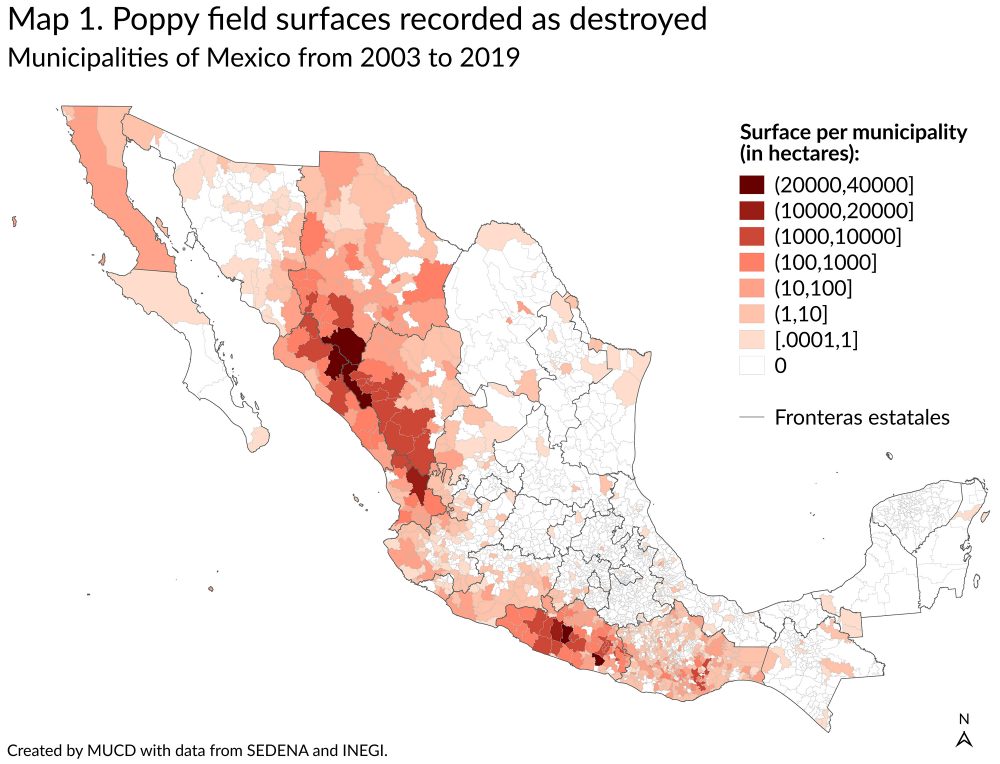
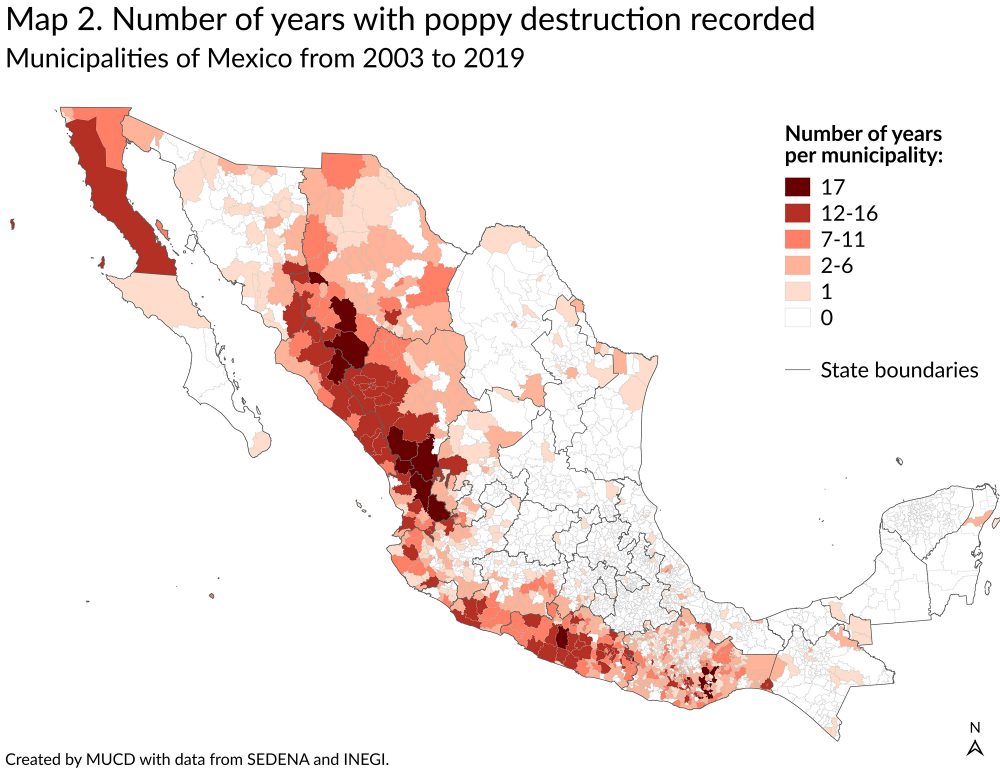
Based on these two measurements (magnitude of destructions in hectares and their recurrence in number of years), we were able to identify a group of 59 municipalities that concentrated the declared efforts of SEDENA in the field of poppy eradication throughout the 17 years of the study period and that we will call “poppy-growing” municipalities.8 In physiographic and political-administrative geography terms, this group of “poppy-growing” municipalities can be divided into three large regions:
- A northwestern region, made up of the mountain chain that extends from the Chihuahuenses’ and Duranguenses’ Great Plateaus and Canyons, to the Plateaus and Ravines of the South (where Durango, Sinaloa and Nayarit converge) and encompasses the Pie de la Sierra (which crosses the entire state of Sinaloa).
- A southwestern region, which encompasses a group of Guerrero’s municipalities (together with two municipalities in the extreme west of Oaxaca) that are located in the Southern Coastal Mountain Range.
- A southern region, located in the convergence zone between the Southern Coastal Mountain Range and the southernmost portion of the Eastern Sierras, in Oaxaca.
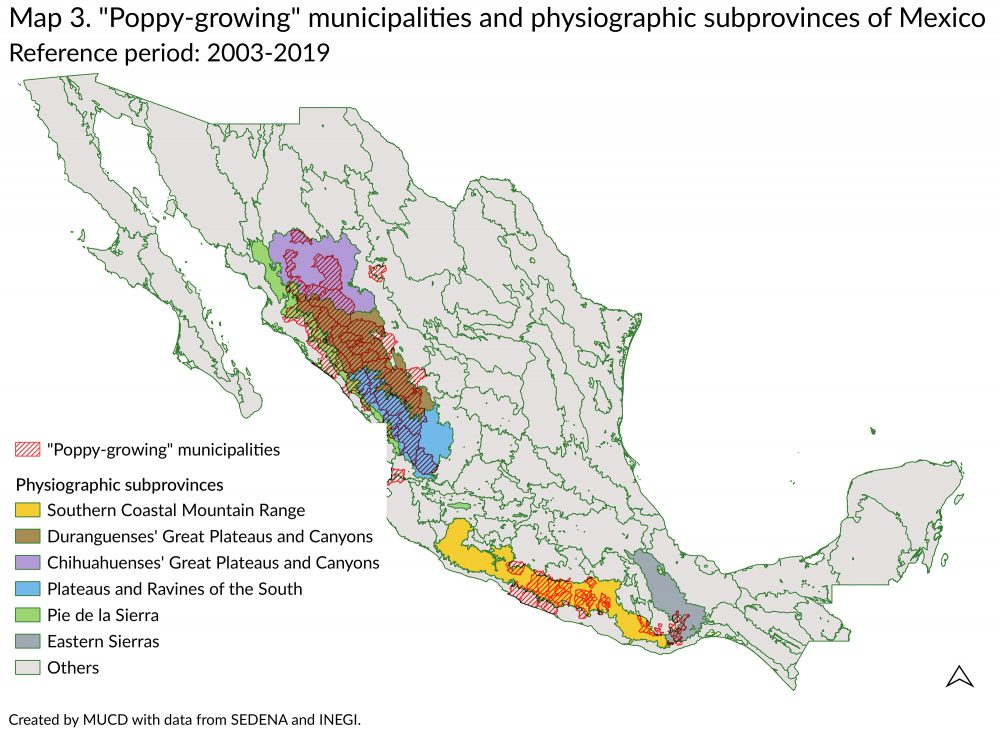
Consistent with other studies, we found that the three identified regions share a similar orography, with elevations of up to 3,400 m in the southern and southwestern regions and up to 3,200 m above sea level in the northwestern region.9 Regarding land use, most of these territories are covered by forests and jungles (74% of the surface), while agriculture occupies only 15% of the total surface (against 19% at the national level). However, divergences are also observed in other aspects, such as climate, access to water resources or even forms of agrarian organization,10 which is reflected in a selection of cultivated plants, obtained yields and therefore heterogeneous benefits generated, as we will see further along.
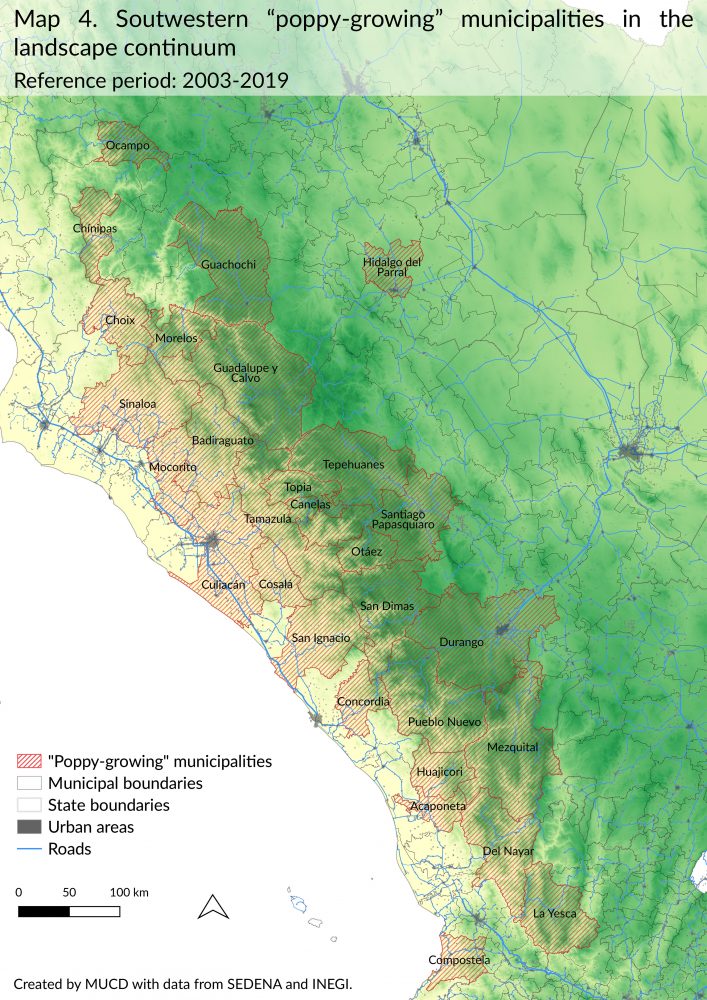

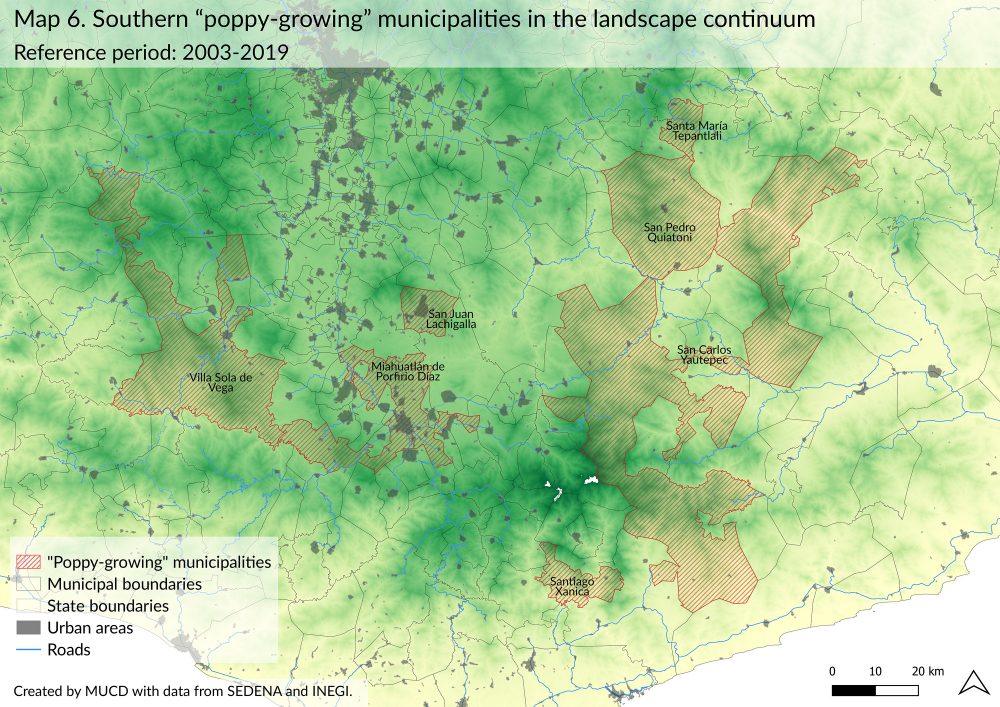
What legal crops can be found in the “poppy-growing” municipalities?
In the first place, it is important to relativize the space that poppies occupy in cultivated lands. In the group of 59 “poppy-growing” municipalities, on average, one hectare of poppy was recorded as destroyed for every 38 hectares of legal crops planted between 2003 and 2019.
As we mentioned earlier, the SEDENA figures do not constitute an accurate reflection of the number of hectares cultivated with poppy. Even so, if we consider a scenario in which the poppy areas registered as destroyed were an underestimation of the cultivated areas, it is unlikely that poppy fields occupy the majority of the cultivated fields in any municipality.11
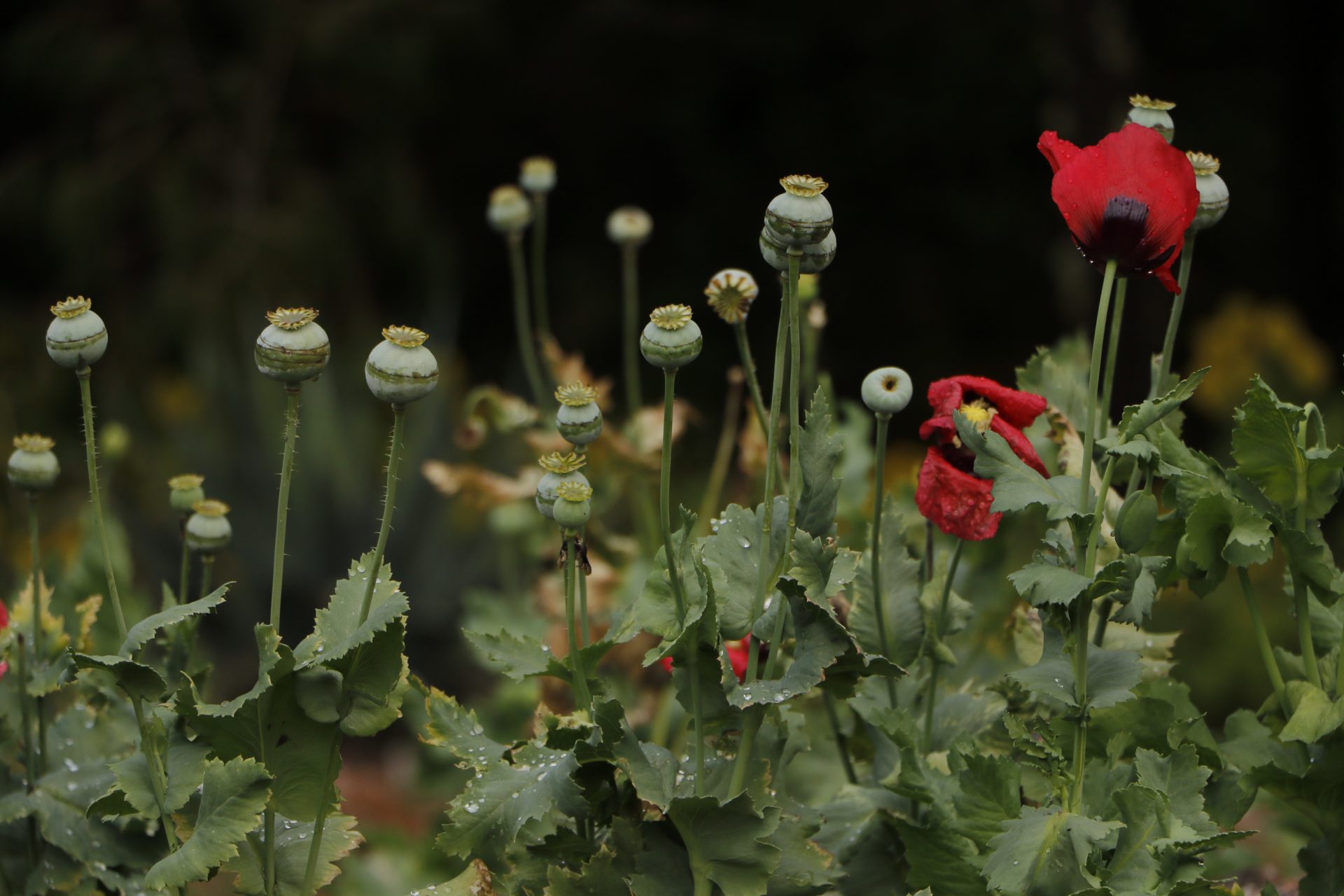
In this sense, even in municipalities with the highest ratios of poppy/legal crops, poppy coexists with other types of agricultural products that are anything but marginal.
Likewise, it is important to consider that, in Mexico, poppy cultivation occurs in agricultural settings strongly dominated by the production of maize. Indeed, among the different types of legal crops registered by SIAP in the “poppy-growing” municipalities, maize was the one that generated the most value between 2003 and 2019 (105,066 million pesos, equivalent to 37% of the total value produced by the agricultural sector in these municipalities) and which occupied most of the planted area (8.5 million hectares, equivalent to 45% of the total planted area), with average prices of grain that doubled from 2003 to 201912 and average yields that went from 2.2 tons per hectare to 2.6, although with notable differences between municipalities and regions.13 In this context, it is essential to ask ourselves if the dynamics of maize production and commercialization can influence the decision to cultivate poppy or not (an issue that we will address in the third section of this text).
However, the omnipresence of maize should not hide the heterogeneity of crops that complete the agricultural panorama of each municipality. In terms of areas, for example, different groups of municipalities can be identified according to the types of legal crops most planted. Likewise, we identified that most municipalities combine the production of maize with some crop of high commercial value (such as beans, avocado, sesame or hibiscus) and/or forages (pastures, sorghum or oats, among others), as shown in Table 1.[mfn]Although the vast majority of the “poppy-growing” municipalities are found entirely in physiographic subprovinces with mountainous relief, some also include coastal or very low-altitude territories (like in the cases of Petatlán, Técpan de Galeana, Coyuca de Benítez and Atoyac de Álvarez, in Guerrero, from Culiacán, San Ignacio and Concordia, in Sinaloa or from Compostela in Nayarit).
Since poppy production in Mexico is usually carried out at altitudes above 1,700 m above sea level (Ospina, Tinajero & Jelsma, 2018), we consider it unlikely that the typically coastal crops that we find in these municipalities (such as copra, mango or sugar cane) will develop in the same areas of the municipal territory.[/mfn] These combinations of crops draw heterogeneous agricultural landscapes, with municipalities that are close to maize monoculture (Alcozauca de Guerrero, Atlixtac, Copanatoyac, Zapotitlán Tablas and Coicoyán de las Flores, in the southwestern region) and others that are characterized by a more balanced distribution of crops in terms of planted areas (such as Compostela or Durango, in the northwestern region).

On the other hand, the value of agricultural production14 generated by municipality is also extremely uneven.
If we weight the total value of production by the total areas sown by municipality, we obtain ratios of value produced per hectare that give us even more insight into the heterogeneity of agricultural contexts in which poppies are grown: some of them with a high value generated per area (such as Culiacán, where an average of 30,279 pesos was generated for each hectare planted between 2003 and 2019) and others that resemble subsistence agriculture (such as Badiraguato or Chínipas, where the ratio was only 2,200 pesos per hectare planted). In this context, measuring the value produced per hectare helps us to assess how important poppy cultivation can be in the different agricultural landscapes where it is found. Although poppy does not usually occupy vast spaces compared to other crops, it does seem to represent a primary source of income in municipalities that only produce low-valued types of crops.
In a 2019 study, Le Cour Grandmaison, Morris & Smith present some prices and production values per hectare of opium gum (a product that is harvested from the poppy plant), which they were able to estimate from field research in Nayarit and Guerrero. The researchers report, for example, that in 2017 in a community of the Del Nayar municipality, the net benefit of the annual production of opium gum came to represent up to 200,000 pesos per cultivated hectare15, while the following year it fell to a “historical minimum” of 64,000 pesos per hectare (with prices of 8,000 pesos per kilogram). By way of comparison, in the same municipality Del Nayar the legal crop that generated the most value per hectare in 2018 was that of lemon16 with 36,000 pesos per planted hectare (without discounting the costs of labor and other production inputs), which it is equivalent to a net benefit per hectare of approximately 8,000 pesos per hectare17, that is, a profitability eight times lower than that of poppy in a year with low prices for opium gum. Although a differentiated poppy cultivation profitability analysis would be required for each municipality (or even at the intra-municipal level), this example shows how attractive poppy growing can be in territories with few legal alternatives of high commercial value, despite the risks incurred by its illicit character.
How do legal crops influence poppy production?
Looking back at the main types of legal crops in the “poppy-growing” municipalities, it is interesting to observe how their production and valuation have evolved over the years and to ask ourselves if some dynamics might have influenced the cultivation of poppies.
In the first place, it should be considered that any crop, legal or illegal, is exposed to climatic phenomena, pests, diseases or other types of effects that can induce losses in the planted areas. When planted areas register a total loss, they are known as damaged and these can represent a considerable proportion of the crops at the scale of a municipality, endangering the communities that depend on agricultural production both socially and economically.
In the case of maize, which represents the predominant legal crop in most of the “poppy-growing” municipalities, we can observe that the damaged area per municipality between 2003 and 2018 represented 7.6% of what was sown for this type of crop. However, vulnerability to the damages appears to be uneven between and within our regions of interest.
While the southwestern municipalities suffered an average total loss of 4.5% in their areas planted with maize grain, this proportion was 8.8% in the northwestern municipalities and 12.6% in the southern ones. And within the southern region, the municipalities of Miahuatlán de Porfirio Díaz and San Pedro Quiatoni were particularly affected during the period studied, with annual losses equivalent to a quarter of the planting on average. In fact, in San Pedro Quiatoni, the scarcity of water for agricultural production was still one of the main problems of the municipality at the beginning of the last decade, considering that 70% of its population is dedicated to agriculture.18 This was reflected dramatically in 2004, when the whole 1,700 hectares of maize grain that were grown without irrigation (waiting for the temporary rains of the spring-summer cycle) were damaged.
The following year, no one sowed19 again and when a new attempt was made in 2006, 99% of the maize grain area sown without irrigation ended in total loss. Faced with the risk of accidents from legal crops highly dependent on temporary rains and the economic losses that may be unsustainable for farmers, the resistance of poppies to droughts represents another incentive for their production.20
On the other hand, the study “From maize to haze” published by Dube, García-Ponce & Thom in 2014, found that the fall in the price of maize grain in Mexico, accentuated by the entry into force of NAFTA21 in 1994 and halted by the world food price crisis in 2006-2008, caused an increase in the eradication of marijuana and poppy crops (which the authors consider as a proxy variable for production). Looking back at this outcome, we analyzed the evolution of the average rural price of maize grain in the 59 “poppy-growing” municipalities during our study period (2003-2019) and found that, although there was an increasing trend in the three regions from 2007 to 2012, regional dynamics during the subsequent seven years were heterogeneous. While, in the southwest region, the price only fell during 2013 before gradually increasing again until 2019, the decline observed in the northwest region lasted two years, and in the south region it lasted five years.
Following the findings of Dube, García-Ponce & Thom (2014), and considering that the 59 “poppy-growing” municipalities cultivate maize grain, we thought that poppy areas recorded as destroyed would have decreased as the maize grain price raised. However, graph 1 presents contrasting scenarios. Although this relationship seems to hold in the municipalities of the southwestern region as of 2010, the phenomena recorded in the south and northwestern regions show independent dynamics.22
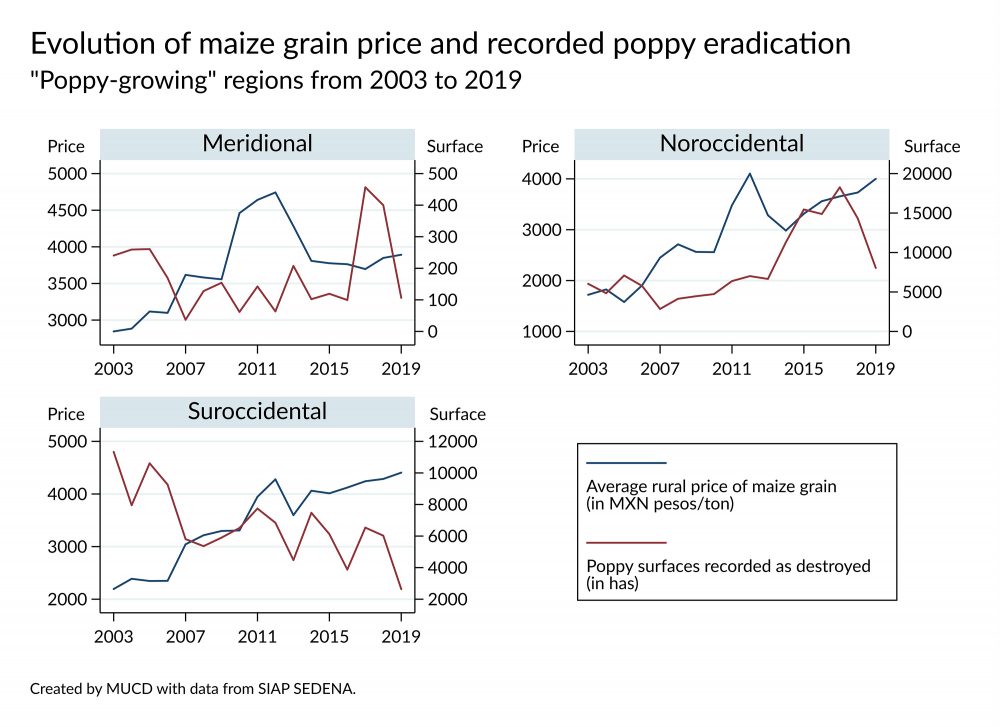
In this context, a complementary study would be necessary to:
- Identify the set of political, strategic and economic factors that can influence the prioritization by the authorities of certain municipalities for the (real or apparent) eradication of poppies.
- Estimate the difference between poppy areas registered as destroyed and areas actually cultivated and appraise if this difference follows patterns differentiated by regions or municipalities.
- And finally, compare the evolution of the price of maize grain with the real production of poppy.
Conclusion
Although Mexico records one of the largest illegal production of poppies in the world, its social and economic importance in the national agricultural landscape are seldom addressed.
The red flower is not found randomly in the republic, since the efforts of the army to destroy it during the last two decades have concentrated in a group of only 59 municipalities. These are perched in three mountain regions that extend along the Pacific coast and that despite sharing certain physiographic and social characteristics, are also distinguishable by strong disparities.
From Culiacán (Sinaloa) to San Pedro Quiatoni (Oaxaca), passing through El Nayar (Nayarit) and Leonardo Bravo (Guerrero), the legal alternatives to poppy cultivation are heterogeneous. While in some territories the poppy is merely one more product (although certainly more profitable) within diversified scenarios of commercially valued crops, in others it constitutes one of the few alternatives to the low profitability of the land and the vagaries of temporary rains. From this, we conclude that poppy dependency and the vulnerability conditions that characterize the people who cultivate it reflect the pervasive inequality in Mexico.
Before being transformed into opium gum and heroin, the poppy grown in Mexico is simply another plant, and those who produce it are none other than workers in the primary sector who are willing to take an additional risk. Understanding poppy cultivation in Mexico will require further investigation into the logic of agriculture in the country and the social conditions in which it operates.
Annexes

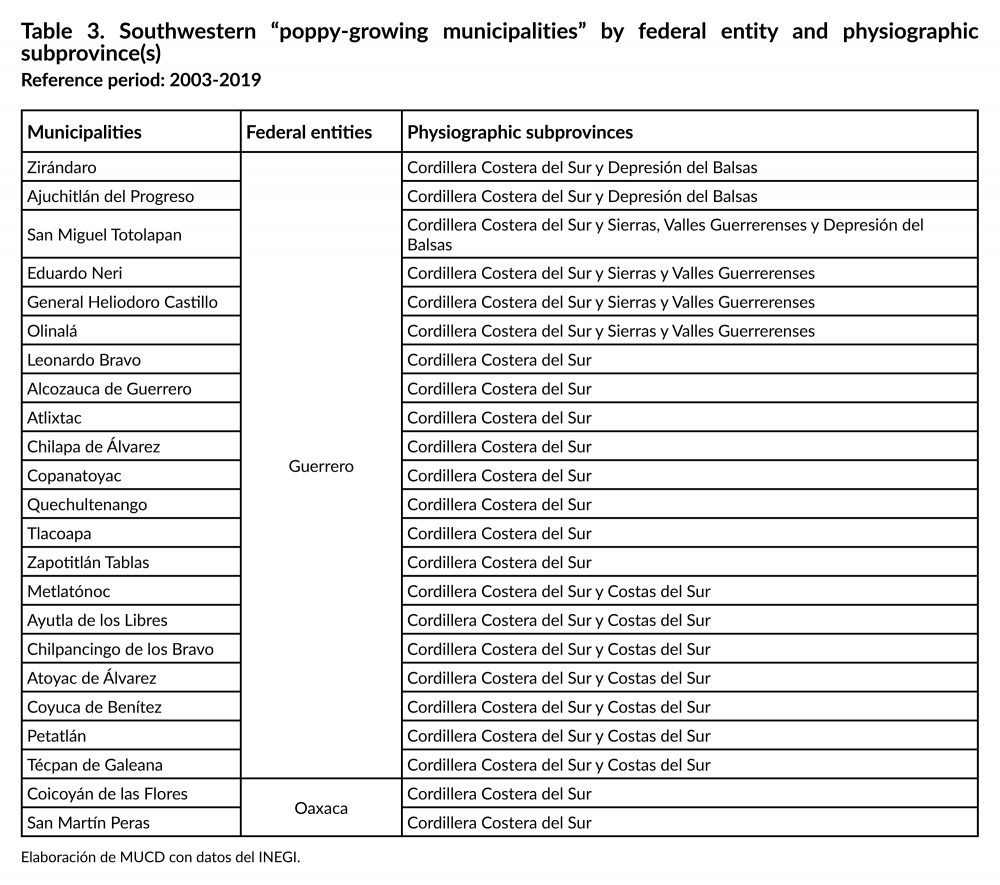
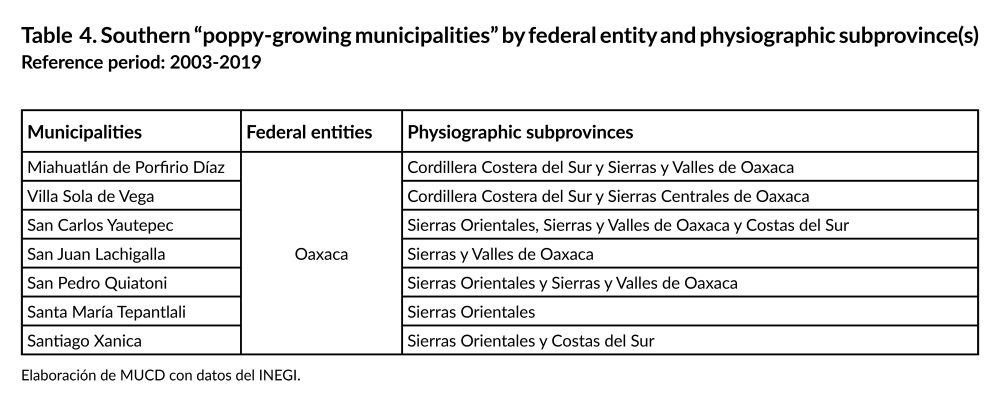
Go to Chapter n°2 of the Opium Project
Go Back to the Opium Project’s Main Page
Click here to go back to the Dossier’s outline.
Notes
- Cf. UNODC, World Drug Report 2020. ↩︎
- SIAP is a decentralized administrative body of the Ministry of Agriculture and Rural Development (SADER) and formerly of the Ministry of Agriculture, Livestock, Rural Development, Fisheries and Food (SAGARPA). The objectives of the SIAP consist of “generating statistics and geographic information on agri-food matters, promoting, in addition, the concurrence and coordination of the other dependencies and entities of the Federal Public Administration, of the state and municipal governments and of Mexico City, for the implementation of the National Information System for Sustainable Rural Development (SNIDRUS)” (SADER, 2019). ↩︎
- Although it would be desirable to carry out this type of analysis at the ejido or community level, there is no public data on poppy plantations systematized with that level of detail. On the other hand, it is important to note that in the original statistical annex provided by SEDENA (in response to the access to information request 0000700203120), we identified a series of inconsistencies between names of municipalities and registered federative entities (e.g. activities registered in the municipality of Coyuca de Catalán, state of Hidalgo). Therefore, a data cleaning protocol was applied that consisted, on the one hand, of correcting the inconsistencies each time it was possible to determine the probable origin of the registration error and, on the other, of recoding the variables of state and municipality with values “Not Specified” for all ambiguous cases. The original files delivered by SEDENA, the database built from them, and the data cleaning protocols applied will be available on the website of México Unido Contra la Delincuencia: www.mucd.org.mx as of April 2021. ↩︎
- In accordance with the National Action Protocol for the Destruction of Illicit Plantations, signed on June 11, 2018. ↩︎
- See the response to the access to information request 0001700006421. ↩︎
- INEGI identified 2,465 municipalities in the September 2019 integrated geostatistical framework. ↩︎
- The case of Ayutla de los Libres, Guerrero, is peculiar because it concentrates atypically high levels of eradication of poppies registered between 2003 and 2006. In fact, some studies argue that the areas that SEDENA declares to have destroyed in the municipality during that period do not correspond with reality, and were used as a justification for carrying out counterinsurgency operations (cf. Gaussens, Álvarez and Frissard, 2021). ↩︎
- The group of “poppy-growing” municipalities corresponds to the municipalities that have (1) accumulated areas of destroyed poppies equal to at least 133,404 hectares from 2003 to 2019, and (2) at least 12 years in which some poppy destruction was recorded. That is, for both variables, values that are among the 10% highest among the 835 municipalities with some destroyed plantation during the whole period. ↩︎
- According to Ospina, Tinajero & Jelsma, 2018, “in Mexico, the poppy grows well in a range between 1700 and 3000 meters above sea level” and “being an illicit crop (…) it is generally located in hard-to-reach areas.” ↩︎
- According to Garzón & Riveros, 2018, “the low levels of access, the concentration of ownership and the high degree of informality in land tenure” are strongly related to the development of crops declared illegal in Colombia. ↩︎
- For instance, Guadalupe y Calvo (Chihuahua) was the municipality with the largest areas of poppy fields registered as destroyed from 2003 to 2019 (39,748 hectares) compared to the total of legal crops sown (225,067 hectares), with a ratio of 1 h. of poppy destroyed for every 6.6 hectares of legal crops sown. However, the ratio of poppy destroyed over legal crops sown might be higher in some specific areas inside the municipalities. In order to confront this hypothesis, we would need data at the intra-municipal level that we currently lack. ↩︎
- Considering the group of 59 “poppy-growing” municipalities, the average rural price of corn went from 2,039 pesos per ton in 2003 to 4,148 pesos in 2019 (values expressed in current Mexican pesos). ↩︎
- On the one hand, we observe that the average price in force from 2003 to 2019 ranges from 2,400 pesos per ton (in Choix and Badiraguato, Sinaloa or Hidalgo del Parral, Chihuahua) to 4,000 (in Olinalá, Guerrero). The average yields, in turn, vary between 0.7 tons per hectare (in the municipalities of the Great Plateau and the Chihuahuenses’ Canyons) and 7.4 (in Culiacán, Sinaloa, although probably in the coastal plain of the municipality that does not coincide with the cultivation areas of poppy). ↩︎
- According to the Technical Regulations for the Generation of Basic Agricultural Statistics 2019, issued by the Ministry of Agriculture and Rural Development (SADER), the production value at the end of the year is obtained by multiplying the average rural price at the end of the year by the quantity of harvested product, even when the production obtained is not marketed (“that is, when it’s used for the producer’s own consumption, for direct grazing of cattle, is kept in storage in a warehouse, etc.”). ↩︎
- With unprecedented prices of up to 20,000 pesos per kilogram of harvested opium gum. ↩︎
- Although it is a perennial crop that begins to produce four years after sowing or grafting the plant (Sánchez, 2005) unlike poppy, whose complete growing cycle is three to four months (Le Cour, Morris & Smith, 2019). ↩︎
- The net profit (NP) of the lemon crop was calculated as the difference between the production value (V) and the production costs (C), considering the following parameters:
V = $ 35,731.48 MXN, according to the data registered by the SIAP for the municipality of Del Nayar in 2018.
C = V/1.3, where 1.3 corresponds to a cost benefit ratio estimated from the economic profitability analysis of lemon and other citrus fruits found in Pat-Fernández et al. (2015) and Ramos (2015). ↩︎ - Benites, 2011. ↩︎
- Only 68 hectares of irrigated maize grain were sown. ↩︎
- According to several studies, poppy has a moderate water requirement during the early stages of its development and a low one in the following stages (Ospina, Tinajero & Jelsma, 2018; US Department of Justice, 1992). ↩︎
- North American Free Trade Agreement. ↩︎
- As a matter of fact, the correlation coefficients between the average rural price of maize grain registered during year t and the area sown during year t+1 are not statistically significant for these two groups of municipalities. ↩︎

